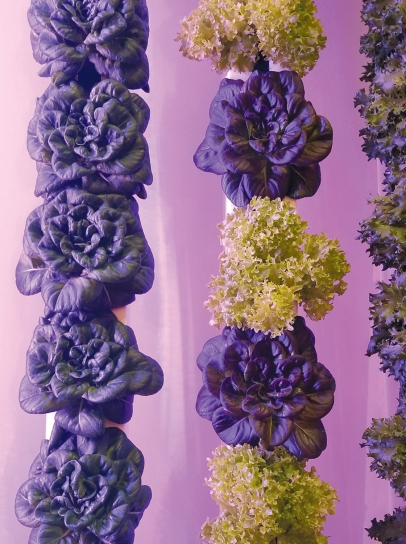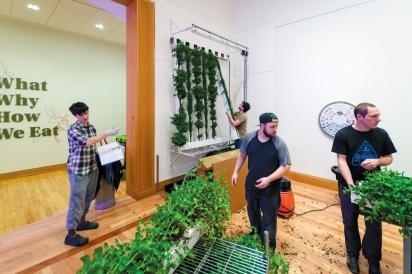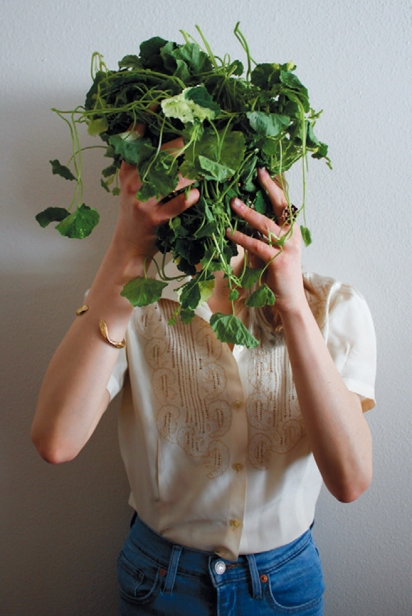The Art of Growing
Produce on View at the Anchorage Museum
Many farmers or gardeners might describe the process of bringing a perfect head of lettuce from seed to table as an art. Right now, at the Anchorage Museum, the art of growing isn’t just a metaphor. Inside the museum’s galleries, the scent of verdant mint wafts. Fresh heads of endive grow alongside healthy stalks of swiss chard and kale in hydroponic units on display in galleries. Derived from the English “hydro” meaning water, and the Greek “ponein,” meaning to labor, hydroponics is the growth of plants without soil, using nutrients dissolved in water.
The Anchorage Museum acquired its first hydroponic unit in 2017, a prototype of the Sunny Pro from Vertical Harvest Hydroponics, or VH Hydroponics. The museum has collaborated with VH, an Anchorage-based agricultural technology company, to refine the unit design and track plant development and harvest rates. This ongoing Discovery Center exhibit grows a variety of herbs, lettuces, and other plants, including some experiments, such as tomatoes and strawberries.
More recently, museum crops have quite literally grown in production scale. Towers from Alaska Seeds of Change, a vocational development program of Anchorage Community Mental Health Services, will grow rotating crops to be harvested every six weeks through January 12, 2020 as part of the “What Why How We Eat” exhibition.
Growing food inside the museum might seem surprising, but these living exhibits connect deeply to the museum’s mission through the year-long “What Why How We Eat” exhibition. As a museum of art, history, science, and culture, the Anchorage Museum connects people, expands perspectives, and encourages global dialogue about Alaska and the North and its distinct environment.
Hydroponic herbs and vegetables in the galleries provide a unique means to encourage just those things to happen. Growing food in the museum inspires considered reflection on the role of food and harvesting in our individual lives and communities. Rows of flourishing chives in a gallery shift notions of where food is grown and how. A leafy head of romaine grown without soil invites questions about the past, present, and future of foodways here in Alaska.
Alaska has a long history of food innovation. For millennia, Alaska native peoples achieved year-round food sustainability through enduring gathering, harvesting, and preserving practices. Thriving in the varied and extreme Alaska climates demands attunement to the land, acute awareness of plant and animal life cycles, and knowledge of how to gather and preserve Alaska’s bounty.
There is some debate about when methods of cultivation took root in Alaska. As colonizers established more permanent settlements on traditionally indigenous lands, they introduced agricultural practices and seeds. As Ken Meter and Megan Phillips Goldenberg stated in the 2014 report, “Building Food Security in Alaska,” Russian explorers likely began gardening in Alaska in the late 18th century, and by the 19th century, cultivation was happening across the state.
Following the purchase of Alaska by the United States in 1867, speculation about potential production and experimentation with farming and agriculture began to burgeon. The Matanuska Valley Colony, a product of Great Recession recovery efforts, was one such experiment. Imported varietal seeds were tested for local growing conditions. As Josephine E. Papp and Josie A. Phillips relayed in Like a Tree to the Soil: A History of Farming in Alaska’s Tanana Valley, 1903- 1940, these early 20th century farmers never were able to meet the self-sufficiency goals they set.
Today, Alaska imports approximately 95 percent of its food, totaling nearly $1.9 billion annually, according to the Alaska Food Policy Council. Bringing that food to Alaska relies on consistent production at major agricultural centers thousands of miles away and uninterrupted shipping routes. Even in the best of circumstances, who has not brought home a box of spinach from the supermarket that molds in a day, or a fine-seeming peach that turns out to be mealy, or a banana that never seems to ripen? And, as recent wildfires, droughts, and floods demonstrate, both production and supply chains for produce are already jeopardized by our changing climate.
Alaska is now at a food sustainability pivot point. How can traditions of eating and harvesting locally inform future economies? What does the future of food look like for our place?
Hydroponics may contribute to the network of solutions needed to address this complex question. The term “hydroponics” first came into usage in 1937 to describe a method of growing plants without soil using a nutrient and water solution. However, evidence for hydroponic methods stretches as far back as the Hanging Gardens of Babylon. Much more recently, farmers, scientists, and entrepreneurs have begun substantial explorations in hydroponic technology as a sustainable growing solution for food supplies in the North. Hydroponics allows indoor, year-round cultivation through cyclical supplies of nutrients and light.
In Anchorage alone, several small businesses using hydroponic methods have sprouted up, including both VH Hydroponics and Seeds of Change. VH Hydroponics has designed a range of units to grow produce on small family scales or to serve larger communities by outfitting shipping containers into growing facilities. The Anchorage Community Mental Health Services’ vocational development program, Seeds of Change, employs at-risk youth to support their substantial growing facility in downtown Anchorage. They supply restaurants with local produce year-round.
Highlighting these innovations from our community in the museum promotes conversation about local resiliency in a global context.
At the museum, the VH Hydroponics Sunny Pro Unit glows a brilliant white in the Innovation area of the Anchorage Museum’s Discovery Center, drawing attention from patrons of every age. Endive, collard greens, romaine, butter lettuce, spinach, herbs, kale, and chard grown in the unit feed the museum’s bearded dragons, blue-tongued skink, tortoise, and turtles. In the “What Why How We Eat” exhibition, the transportive scent of the growing herbs captures the imagination. Staff members take lettuce and herbs home and make bountiful salads, earthy sauces, and savory soups. Both units keep up the nutrient solution and water. As long as this routine is maintained, a regular, abundant harvest is virtually guaranteed. This offers a small example of the sustainable cycle hydroponics can provide.
Much must be considered before bringing hydroponics into the museum. Conservator Sarah Owens and her museum colleagues monitor the units closely to ensure that growing produce does not attract non-human consumers. Hydroponic methods are more conducive to the sensitive environment of the museum as they reduce introduction of variables like outside soil. Areas around the units are cleaned regularly and vigilantly. In a recent conversation, Owens shared that for her, having the units in the museum was meaningful because of the important questions and conversations they generate about food in Alaska.
For me, as Director of Learning and Engagement at the Anchorage Museum, there is something magical about encountering healthy produce every day in our galleries. Every morning I can walk past fresh, leafy plants no matter the weather outside. I can measure the passage of time by how high the stalk of the basil is, how leafy the kale. Throughout the dark winter, sprouting seeds twine towards the light. These little glimpses of growth inspire awe.
The sense of wonder these encounters with produce provoke in me are at once similar and different to the feelings evoked in me by spending time in front of a precisely hewn box drum or a piercing photo from the Anchorage Museum collection. When I spend time with an object from our collection, I am moved in the way that I see myself as in relationship with others—as connected to past, present, and future communities of diverse people sharing the beauty and resources of Alaska over time.
When I stand in the glow of the ultraviolet bulbs of our hydroponic units and take home a bag of mint and prepare a meal with it, I cannot help but think about my position as part of a larger system. I feel connected to past, present, and future practices of growing, harvesting, and eating. As my colleague, von der Heydt Chief Curator Francesca DuBrock, said, “Just the smell of the plants alone helps to stimulate the idea that food is part of a living system. We’re part of that living system. The immediacy of the hydroponic display helps convey that message...”
Hydroponics isn’t the single answer to supporting food production in Alaska, and growing produce in the Anchorage Museum doesn’t answer many questions that need to be asked and resolved. The Anchorage Museum hydroponic exhibits do serve as one example among myriad innovations and technologies that comprise the multifaceted, dynamic approach needed to establish sustainable food sourcing here in Alaska.
A bunch of mint can prompt dialogue about resilient foodways. A twining nasturtium can invite consideration of the complexity of our individual and collective relationships to food.
This is the art of growing happening at the Anchorage Museum. The simple, but unexpected, encounter with produce growing in galleries asks us to look at food differently and see our relationship to it in new ways. When we see ourselves as part of the larger food system, we are called back to question: What does the future of food look like for our place? What is the future of my food, our food, in Alaska?
In her new column, Culinaria Obscura, S. Hollis Mickey uses archival research to examine contemporary Alaskan foodways.
The Anchorage Museum’s Urban Harvest adult class series considers the connection of contemporary Alaskan lifeways and foodways to their histories and contexts. Find out more on the museum’s website.
Check out the class about homegrown hydroponic produce on September 10 with Cole Murphy of Seeds of Change—Urban Harvest: Simple Home Hydroponics. anchoragemuseum.org







